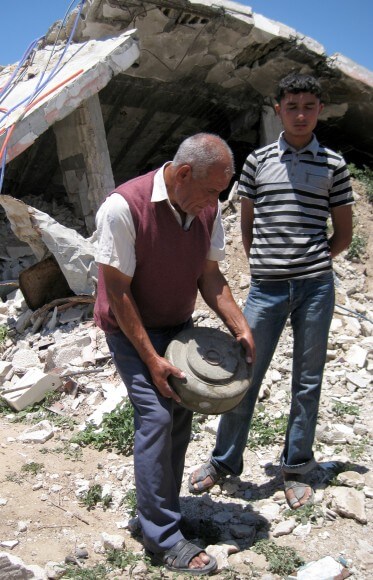
Israel’s war against Palestine is a graveyard of questions that died begging to be asked.
The media report Israel’s actions accompanied by explanations that Israel itself supplies. The Palestinian family was thrown out of their home because they are not legal residents of East Jerusalem. The ambulance was bombed because it was transporting terrorists. Ten thousand Palestinians are in prison because they were militants planning attacks. The house was bulldozed because it was built without a permit. These lines satisfy a compliant media; no questions are asked.
For the fourteen months following its so-called Cast Lead attacks of Dec 27, 2008 to Jan 18, 2009, Israel steadfastly blocked UN bomb experts from neutralizing the huge stockpile of unexploded ordnance (UXO) it left behind in the Gaza Strip.
Thus for fourteen months Israel ensured that the ordnance, which constituted a vast cache of explosives, could be taken by Palestinian militant groups.
Why?
After Israel formally ended Cast Lead, the United Nations Mine Action Service, along with the British organization Mines Advisory Group, a Nobel Peace Prize winner, began collecting the formidable arsenal of UXOs that Israel had left behind. Their task was urgent—the weapons had to be destroyed so that they could not harm civilians or be scavenged by militant groups.
But when the UN tried to bring the equipment it needed to dispose of the ordnance, Israel—though it has no legal jurisdiction in Gaza, and though it claims not to be occupying Gaza—stopped them.
The bomb experts managed to dispose of some white phosphorus shells by submerging them in water and covering them with sand.[1] But the vast majority of the UXOs could not be destroyed until Israel stopped blocking the UN from bringing in its equipment.
So the UXOs remained stockpiled, a danger to the nearby densely populated areas, and a temptation to militant groups. The munitions were of course guarded—but by the very same Gazan police force that Israel had specifically targeted during the first days of Cast Lead, claiming that they were not a civilian force, but Hamas’ police.
The first news of Cast Lead ordnance getting into the hands of Israel’s adversaries came in early February, when Hamas publically displayed weapons it had collected, including unexploded one-ton bombs, half-ton bombs, 250 kilogram bombs, 30 mm bombs, several types of anti-tank missiles, illumination rounds, and the mines that Israel uses to blow up houses.[2]
Yet Israel continued to block the UN from destroying the stockpiled UXOs.
After another couple of weeks of stonewalling—by now mid-February—Israel issued an extraordinary statement in response to relief workers’ protests. The statement read as follows:
“The conclusion that the IDF is not permitting the [UXO disposal] force’s entry lacks all factual basis, since no response has been issued. The issue is being considered with a favorable eye and the IDF’s answer will be given within a few days.”[3]
Before “a few days” were even up, five tons of Cast Lead UXOs disappeared from the stockpile the UN was waiting to destroy, the inevitable result of Israel’s interference. Israel immediately blamed Hamas; but whether it was Hamas or another militant group, Israel spun the incident — accurately — as a blow to its security.

The media seized on the story of Hamas “stealing” bombs, but were mute about the circumstances. The New York Times reported simply that the ordnance had been “awaiting safe disposal by a team working with the United Nations.”[4] The reader was led to believe that the UN team simply hadn’t gotten around to it.
The few media that made any mention of why the UXOs were not being destroyed, did so with remarkable credulity. Haartez reported that the UN team’s “work is being held up because Israel has not approved the entry of its equipment nor an area for storing and neutralizing ordnance.”[5] The BBC said that “the UN staff had been waiting for the Israeli army to allow them to bring specialist equipment [and] were also waiting for permission from the Israeli military to use two safe areas to dispose of the munitions.”[6] No media expressed the slightest curiosity about these strange statements and the questions they beg.
Even after these five tons of stockpiled bombs ended up in the hands of its sworn enemies, Israel still refused to allow the UN to deactivate the remaining UXOs. In late May 2009—three months after the IDF’s “no response has been issued” statement, and under continuing pressure from the UN—Israel consented “in principle” to stop blocking the UN, but only “in principle.”[7]
A UN Mine Action Service expert who was involved with the situation in the Gaza Strip at the time told me, with an air of bewilderment, that Israel continually presented its obstruction of their work as “bureaucratic… needing permission from senior rank etc.” But as for getting an explanation of the delays from the relevant Israeli agencies, the “chances of getting a reply,” the officer told me, “are about as likely as the election of Khaled Meshal as Israeli prime minister”[8] — precisely zero.

Not until ten more months passed, on March 10 of 2010, did Israel finally “allow” the bomb experts to bring in their equipment into the Gaza Strip and begin the destruction of the remaining Cast Lead ordnance. This was one year and two months after Cast Lead ended.
Israel’s professed reason for its siege of Gaza is to keep weapons-making materials out. Israel bombs Gaza’s borders and shells its coast, routinely fires on Gazan farmers and fishermen, and pirates international aid ships, with the mere claim that its blockade is being penetrated.
What ostensibly is Israel’s worst nightmare began the moment Cast Lead ended—a vast stockpile of explosives inside the Gaza Strip, guarded by agents of Hamas. But Israel’s reaction to this was fourteen months of “bureaucracy” that blocked the weapons’ destruction.
At best, Israel was unconcerned by the presence of a vast stockpile of explosives inside the Gaza Strip that might be repackaged and sent over the Green Line.

Yet “unconcerned” is a generous interpretation. Israel not only failed to act to eliminate this threat to its security, but actively prevented its elimination. Israel deliberately ensured that militant groups could obtain weapons materials.
It is interesting to point out that in mid-September 2010, Israel began reporting a new phenomenon: white phosphorous shells fired into southern Israel from Gaza.[9] The media reported this, of course—but not the militants’ likely source for these shells.
Whether one condemns militants’ rockets as terrorism, dismisses them as politically stupid, or justifies them as self-defense, is irrelevant to the issue. Israeli historians familiar with Zionist records have documented how Israel, historically, has provoked attack in order to justify retaliation (“defense”).[10] The Western media rarely report Israeli attacks against Palestine, only the Palestinian response.
However obvious it may seem that maintaining an external threat remains Israel’s modus operandi, it is difficult to prove. One must show not only that Israel’s actions work counter to its security, but that the very purpose of its actions is to do so.
And that is the significance of its interference with the disposal of the UXOs: Israel knew full well that the result of its actions would be the continuation of the very attacks it used to justify Cast Lead.
Israel must be challenged to explain why it blocked the destruction of ordnance in Hamas-controlled Gaza for over a year. If the media investigated this and myriad other unasked questions, critically and independently, the Israel-Palestine debacle would begin to look quite different to the Western public — the people upon whose acquiescence Israel’s ethnic cleansing of Palestine depends.
Thanks to Nancy Elan for her assistance. Photo credit, Tom Suarez.
1. “Gaza mine-clearing teams waiting for Israeli okay,” Haaretz, 17 February, 2009.
2. Landmine Monitor Report 2009, Palestine. Also Amira Hass, “Gazans set up make shift exhibit of Israeli weapons used in Cast Lead,” in Haartez, 4 February, 2009
3. ibid.
4. “American Lawmakers Visit Gaza,” NY Times, 18 February, 2009.
5. “Gaza mine-clearing teams waiting for Israeli okay,” Haartetz, 17 February, 2009.
6. “Explosives haul missing in Gaza,” BBC News, 17 February, 2009.
7. Elena Rice [U.N. Mine Action Service] “The Rapid Response to Operation Cast Lead,” in The Journal of ERW and Mine Action, Winter, 2009.
8. Email correspondence between a United Nations Mine Action Service Officer and the author, March, 2010. The Israeli agencies the UN team was dealing with were COGAT (Coordinator of Government Activities in the Territories) and CLA (Coordination and Liaison Administration). Khaled Meshal is the major Hamas figure, best known for the bungled, stranger-than-fiction assassination attempt against him by Mossad in 1997.
9. “Terrorists fired 2 phosphorus shells into Israel,” in Jerusalem Post, 15 September, 2010.
10. For example, Ilan Pappe, Ethnic Cleansing of Palestine, p51-52 [Oneworld, 2006]; and Zeev Maoz, Defending the Holy Land [University of Michigan Press, 2009].

